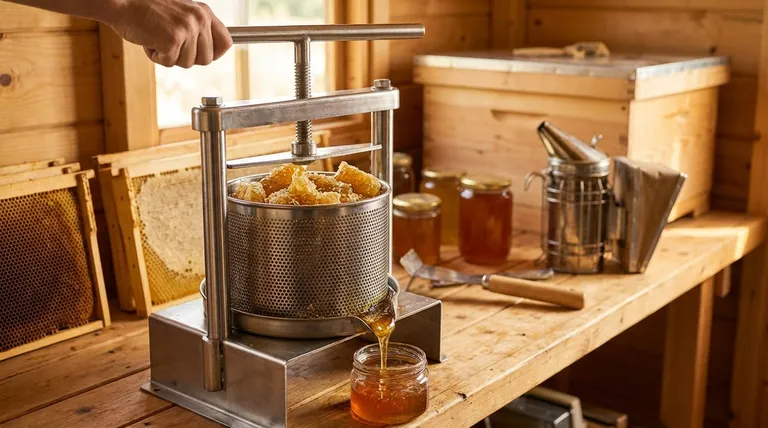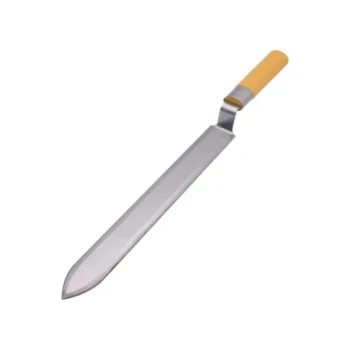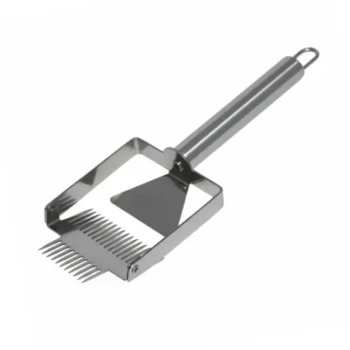At its core, a honey press is a mechanical device used to extract honey from raw honeycomb. Also known as a comb crusher, it functions by applying immense pressure to the comb, squeezing the honey out, which is then collected in a container below. It is a straightforward and effective tool, particularly favored for smaller-scale operations.
The fundamental purpose of a honey press is to separate honey from wax through crushing. This makes it a simple and often affordable method, but one that inherently destroys the honeycomb in the process.

The Core Function: Crushing vs. Spinning
The method a honey press uses is the key to understanding its place in beekeeping. It operates on a principle of brute force, which has distinct advantages and disadvantages compared to other extraction methods.
How a Honey Press Works
A honey press uses a simple screw mechanism. Beekeepers place chunks of honeycomb into a perforated basket or cage. By turning a large T-handle, a press plate is driven down onto the comb, crushing it and forcing the liquid honey out through the perforations.
The honey drains from a spout at the base of the press into a waiting bucket or container.
The Key Difference: Destructive Extraction
This crushing method destroys the honeycomb, leaving behind a compressed block of beeswax. This is the single most important distinction between a press and a centrifugal honey extractor.
An extractor uses centrifugal force to sling honey out of the comb's cells while leaving the wax structure intact. This allows the beekeeper to return the empty "drawn" comb to the hive for the bees to refill.
Why Choose a Honey Press?
Despite the destructive nature of the process, a honey press is an excellent choice in several common scenarios.
Simplicity and Accessibility
The design is simple, durable, and easy to operate. It does not require electricity and is well-suited for beekeepers who want to extract honey from a small number of frames without a complex setup.
Multipurpose Versatility
A significant advantage is its versatility. The same press can be used for other agricultural tasks, such as pressing juice from fruits for cider or extracting juice from berries for winemaking. This makes it a valuable tool for a homesteader or hobby farmer.
Ideal for Warre Hives or Top-Bar Hives
Beekeepers using foundationless hives, like Warre or top-bar hives, often harvest by cutting the entire comb out. Since the comb will not be reused in a frame, a press is a perfect method for extracting the honey.
Understanding the Trade-offs
The decision to use a honey press requires acknowledging its primary limitation.
The Loss of Drawn Comb
The biggest trade-off is the destruction of the wax comb. Bees expend a tremendous amount of energy and resources (consuming many pounds of honey) to produce just one pound of wax.
By destroying the comb, you force the bees to rebuild it from scratch. This diverts their energy away from foraging and honey production, potentially reducing the next season's harvest.
More Wax and Debris in the Honey
The crushing action forces not just honey but also fine wax particles and other potential debris through the filter basket. Honey extracted with a press almost always requires more thorough filtering or straining to achieve a clear final product.
Inefficient for Large Operations
For a beekeeper with many hives, a honey press is a slow, batch-by-batch process. A centrifugal extractor is far more efficient for processing a large number of frames quickly.
Making the Right Choice for Your Goal
The best extraction method depends entirely on your beekeeping scale, hive type, and philosophy.
- If your primary focus is simplicity and small-scale harvesting: A honey press is an excellent, cost-effective choice, especially if you also want to press fruit.
- If your primary focus is maximizing honey production and preserving bee resources: A centrifugal extractor is the superior investment because it saves the valuable honeycomb for reuse.
- If your primary focus is processing wax cappings or irregular comb: A press is a fantastic secondary tool for any beekeeper to extract the last drops of honey from wax cappings that are sliced off frames before extraction.
Understanding this fundamental trade-off between comb preservation and operational simplicity empowers you to choose the right tool for your beekeeping journey.
Summary Table:
| Feature | Honey Presser | Centrifugal Extractor |
|---|---|---|
| Method | Crushes comb with pressure | Spins honey out, preserving comb |
| Best For | Small-scale, Warre/top-bar hives, homesteaders | Large-scale, maximizing honey production |
| Comb Reusability | No, comb is destroyed | Yes, comb is preserved for bees |
| Key Advantage | Simple, affordable, versatile (e.g., fruit pressing) | Efficient, saves bee resources, clearer honey |
Ready to choose the right extraction tool for your apiary?
At HONESTBEE, we supply durable, commercial-grade beekeeping equipment to serious beekeepers and distributors. Whether you're scaling up your honey production or need reliable tools for your operation, we provide the wholesale solutions you need for success.
Contact our experts today to discuss your equipment needs and get a quote!
Visual Guide

Related Products
- All-Stainless Steel Pivoting Honey Uncapping Fork for Beekeeping
- Professional Dual-End Stainless Steel Hive Tool for Beekeeping
- Professional Honey Uncapping Roller for Efficient Harvesting
- Professional Bent Tine Honey Uncapping Fork with Ergonomic Grip
- Stainless Steel Pivoting Honey Uncapping Fork with Plastic Handle
People Also Ask
- What is a decapping knife used for? Unseal Honeycomb for an Efficient Harvest
- What are the common methods used by small-scale beekeepers to uncap honey frames?
- What to use to uncap honey? Choose the Right Tool for Your Apiary
- What is the use of an uncapping fork? A Precision Tool for Hive Management and Honey Harvesting
- What should be checked before harvesting honey from a new hive? Ensure Colony Survival First



















